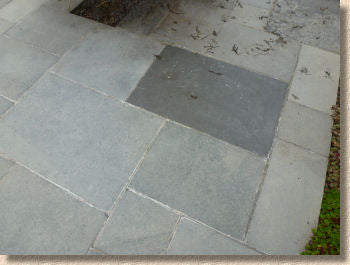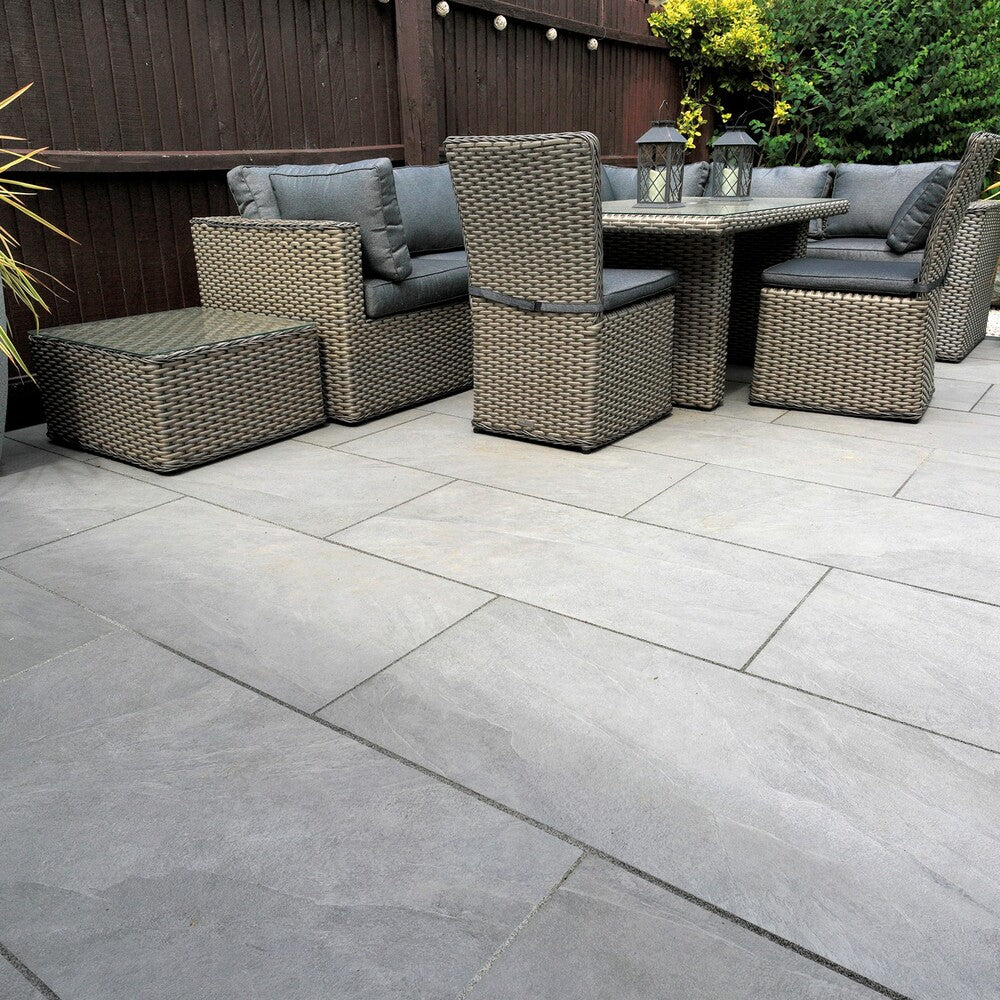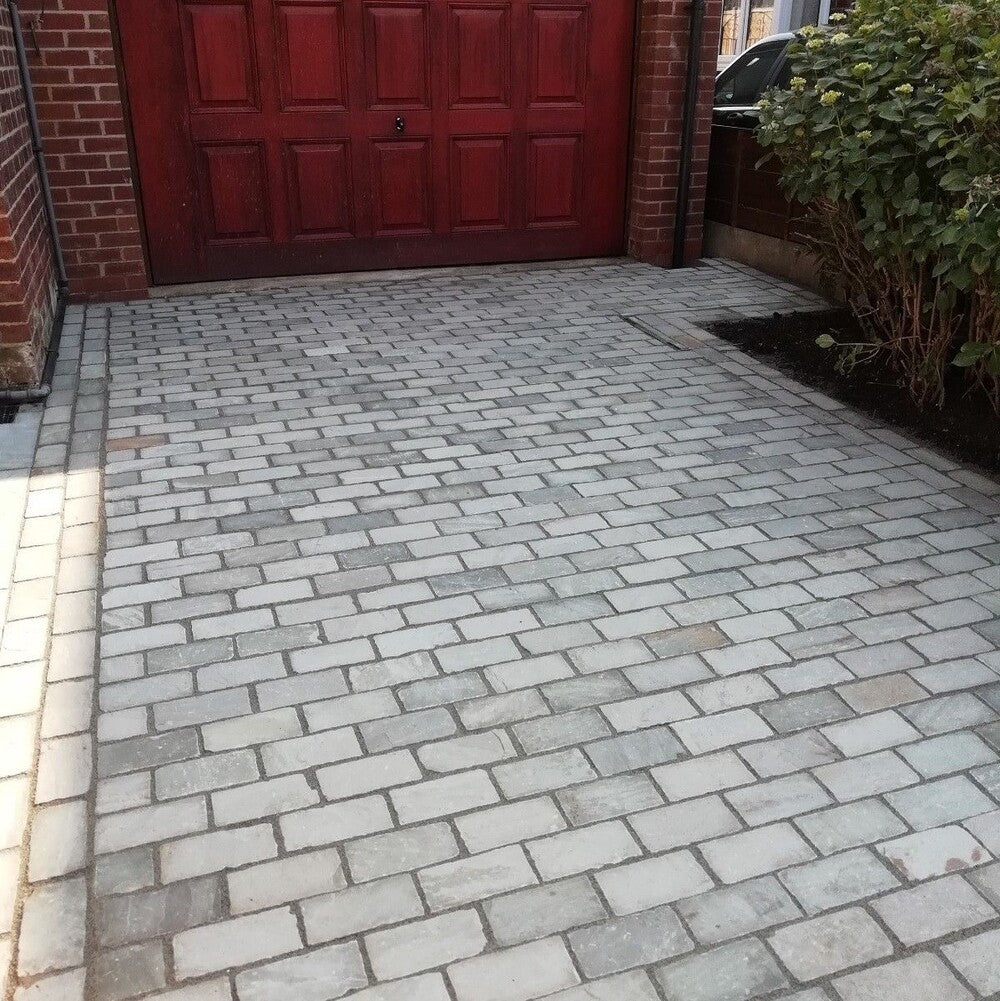Black Limestone paving slabs - once the darling of the industry. No one had ever seen anything like it - a natural, quarried stone that came out of the ground a dark black colour. Incredible! It started appearing on the market around 10 years ago to a great reception.
With monochrome all the rage back then (and even still now), Black Limestone was incredibly popular with many customers. The dark blacks were unlike anything else you could purchase in natural stone. The surface was smooth, the colour was consistent with little variation and the material cut very easily - all-in-all it was a very popular choice. So what happened?
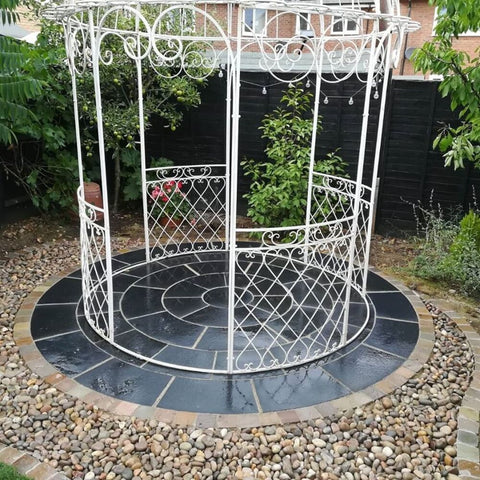
In recent times, Black Limestone has seen a dip in popularity. The stone has remained the same, but the number of requests we are getting for the stone has fallen dramatically. Back in 2010, we simply couldn't stock enough of the stuff - our #1 bestseller - but now we stock a modest amount for the reduced demand. If the stone hasn't changed or got worse in quality, why is this? Well, we think it boils down to something that has come to be known as the "The Curse of Black Limestone", so named by the Pavingexpert in this article.
The suggestion is that Black Limestone fades so quickly from its original deep black to a pale grey colour that it is almost not worth the purchase. If you purchased Black Limestone paving slabs for a dark black finish, then you will be disappointed within weeks. But is this true? Will you be disappointed? Let us go through it point-for-point and hopefully you will be able to decide whether this is the stone for you.

The Curse of Black Limestone - Origins
A few years ago, Pavingexpert wrote the article "The Curse of Black Limestone" - it is a very well researched article and we would recommend giving it a read. They have even run their own Black Limestone test towards the end of the article which is very informative. As a result of this article and the effort put into writing it, the article appears as the number 1 search result for any search relating to Black Limestone which means it's often the first piece of information people find when they begin to look into Black Limestone paving slabs. Whilst a fairly reflective comment on the material, it does paint quite a scathing picture of the material which I can imagine will put many people off before they have even looked into it.
Faded Black Limestone - Source: Pavingexpert
The Curse of Black Limestone - Myth or fact?
So the question comes down to whether this is true, and to what extent.
The simple facts are this:
- Black Limestone will arrive on-site deep black in colour.
- Limestone is susceptible to fade in the sun and rain.
- Black Limestone is liable to fade. But how quickly is a question of quality.
- Either way, Black Limestone is a high maintenance paving slab choice.
- We do have a recommended solution.
Let's look at each of these in turn - hopefully, it sheds a little more light on the so-called Curse and whether the material really is something to avoid.
New Black Limestone slabs - How do they look on arrival?
Freshly quarried and purchased Black Limestone arrives in a fascinating black shade, unlike any other natural stone. The stone is immediately enticing for many, but not something they are overly familiar with:
Check Out Our Black Limestone Paving Slabs
The colours are strong, attractive and are very well suited to a modern, contemporary area. On top of this they are very reasonably priced no matter where you get them from - overall a great choice for many. But as is the case with many things, after having your new patio laid, new kitchen installed or new carpets put down, whatever it may be, the initial WOW! factor doesn't stick around forever and you want to make sure that the product you have purchased is going to last. So it's important to be aware of what can happen to these slabs down the line.
Black limestone paving slabs - Do they pass the test of the UK weather?
The biggest test for Black Limestone is the elements. The sun (however infrequent it may be!) and rain can speed up the ageing process in Black Limestone quite significantly. As we explained, Black Limestone is liable to fade, however, all-natural stone is expected to fade to varying degrees, but Black Limestone suffers particularly badly.
For example, if you take Kandla Grey Sandstone as an example - a very popular sandstone across the UK - this is also liable to fade, but not to the extent of Black Limestone. If anything, the fading/ageing process actually adds to the effect of Kandla Grey slabs.
The reason why Black Limestone suffers so badly is that it is purchased to be the darkest of dark colours. As soon as it begins to fade, you've lost the dark effect, which was the entire reason you made that choice. Not ideal!

Quality Control - is your limestone up to the job?
This is a difficult subject to address. There are varying standards of limestone available, but no hard and fast way to classify them to make sure you are choosing a good quality stone.
However, there are two major types of imported Black Limestone that are simply of different quality.
Kota Black Indian Limestone Paving
This is the Black Limestone that is slightly better quality. It comes from the Kota region of India, hence it's name. This Limestone is a harder material. It doesn't flake and has an almost metallic feel to it. It's an unusual stone and not at all what you'd expect from a limestone, which many people expect to be a softer stone.
Kota Black Limestone doesn't flake at all - it's a very hard stone and as a result is much more resistant to fade. It doesn't have any chalky properties which is so often what speeds up the fade of other inferior stones.
Limestone from Kota is slightly superior to the following material.
Kadapa Black Indian Limestone Paving
This is slightly more in line with peoples expectations of what to expect from a limestone. Kadapa Black is a softer limestone, flaky and chalky when compared to the Kota Black Limestone above. It is also the most imported limestone and therefore the most readily available.
Because it is a softer, chalkier stone, this is the Limestone that is often described as 'cursed'. While both Limestones are going to fade over time without proper maintenance, Kadapa is especially susceptible to these effects. When you see the extreme examples of fade - very white limestone which is completely faded to a horrible colour - it is often going to be Limestone imported from the Kadapa region.

Best Practices When Using Black Limestone Paving
The best thing to do is to look for a reputable supplier with a good track record. Look for quality photography of a project using Black Limestone which has clearly been in use. Next, ask where their particular Limestone has been imported from. A good supplier should know the exact location it came from - warning signs if not!
Ideally, the stone will have come from Kota - but it's not a deal-breaker if it doesn't. Kota Limestone is superior in quality and still widely available, so try and stick to this where possible.
The best way to confirm for yourself is to check that you are able to visit a showroom or display area where the limestone has been laid for you to view. Ask the supplier how long the stone has been laid and what they have done to treat and maintain it. You cannot fully judge any stone until you've seen it laid, but this is especially true of Black Limestone. Avoid buying straight from a crate - always ensure you can visit in person.

The above Black Limestone is from the Kota region and has been laid for over a year - as you can see it still holds it's black colour when wet. Really poor Limestone completely fades within months, and it's almost impossible to tell at a glance what the quality of the limestone is going to be. We cannot make it clear enough that it's super important to see the quality for yourself in any form of display to check you are getting a material that is the best in its class.
Black Limestone - A high maintenance choice
The long and short of it is this - Black Limestone does fade. There is no way around it. Limestone paving as a geological component is susceptible to the elements and as a result, will fade over time regardless. Because of the original depth of colour of Black Limestone, it is very noticeable when it does start to fade. Alternatives such as Blue Limestone and Yellow Limestone - below - also fade over time but the colour stands up to it a little better.


There's really no way around it. If you want a dark, affordable stone, Black Limestone is the answer. But you will have to spend time and effort maintaining the colour in a variety of ways.
Black Limestone - Solutions to avoid fade or restore colour
Popular wisdom would simply advise you to just avoid Black Limestone altogether, but we do not think it is as extreme as that. It's simply a case of being aware of the material and its behaviours and deciding whether you are able to accommodate it.
The first step to ensuring you are setting yourself up for success is to protect the stone from the elements after it is laid. You can do this by using an outdoor solvent-based sealer.
Sealing the stone 8-12 weeks after it has been laid will immediately start to protect the stone from UV-rays and intense winter rain. Using an 'impregnating' solvent-based sealer will mean the stone is protected beyond the surface and the entire makeup of the stone is saturated with a protective substance.
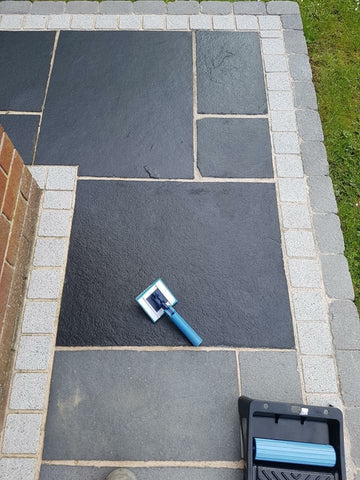
The first treatment won't protect the stone forever. The stone will need a top-up of the sealer every 12-18 months to ensure it stays fully impregnated and is immune to the blight of faded Black Limestone.
If you were looking for advice on sealing other types of stone also, you can see our complete guide here: Do You Need To Seal Natural Stone Paving?
By keeping on top of it, you can keep that deep black colour you purchased the stone for. But it is important to know it will require this extra maintenance and you should not to opt for this material if you are not willing to do the work. You will be disappointed!
Have you purchased Black Limestone which has faded?
Also not a problem! There is a specialist product on the market that was developed thanks to the outbreak of this Black Limestone 'curse'. It is called Back-to-Black Limestone from Azpects and is designed to bring your black limestone paving slabs back to life.
So all is not lost. Black Limestone is a wonderful option for so many and with the evolution of the landscaping industry, there are ways to cure the 'curse' and even avoid it altogether.
The main word of warning when it comes to cleaning or restoring Black Limestone paving is to avoid acid-based cleaners at all costs. We've seen examples where the contractor used acid to clean limestone paving and ruined it beyond repair. A simple power wash and three consecutive dry days mean it's time to use the Back to Black compound.
In Conclusion - The curse is real... But there is an easy cure
Don't write off Black Limestone as an option! It's not a cursed stone that's completely unsuitable for any project. You can have tremendous success with it and create spaces that are incredibly contemporary and really make an impact.
If you can find a Kota Black Limestone as opposed to a Kadapa Black Limestone, it will go a long way to ensure the long-term quality of your project. But we say this with a warning: Only purchase this stone if you are willing to follow best-practice procedures and really take time maintaining it, even if it is the superior quality limestone. The Curse of Black Limestone hasn't just been created as a smear campaign for the material, it's well-founded and tests have been done. The stone will fade and be slightly disappointing if you aren't willing to stay on top of it.
Black Limestone isn't for everyone! Let us make that clear... but for those who want a slab that doesn't cost the earth and are willing to maintain it, it should not be written off altogether.

